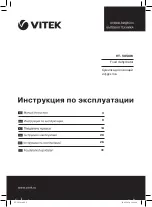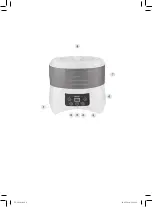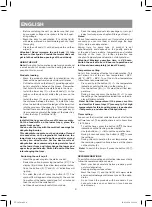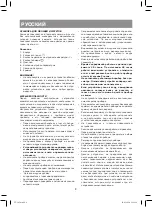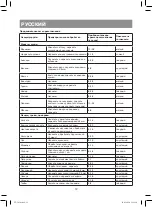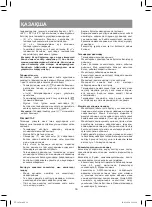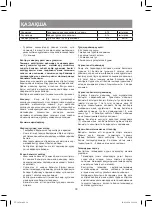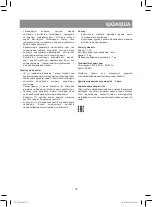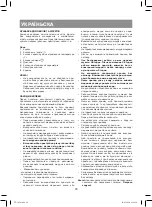
5
ENGLISH
– Checking the food readiness, do not touch the prod-
ucts with your hands; use a fork, a spatula or other
kitchen tools.
– Do not allow pets to enter the kitchen during food
dehydration.
Choosing vegetables and fruit for drying
- Use only fresh fruit or vegetables.
- Only ripe fruit are suitable for drying, green fruit may
acquire a foreign flavor.
- Overripe fruit may change their color after drying.
- Cut off any rotted parts.
- Not all vegetables are suitable for drying because
unlike the fruit vegetables contain less sugar and acid.
It is recommended to freeze some vegetables, for
instance broccoli or asparagus, better than to dry.
– Vegetables are ready if they are hard and dry.
Preparation of products
– Wash the products carefully.
– Remove the stones and rotted parts of the fruit.
– If necessary, peel off the vegetables skin. Always
peel off the skin if the vegetables are covered with
wax.
– Remove the fruit stalks.
– Cut the vegetables or fruit in slices or cubes.
– Berries or grapes should be dried whole.
– Dry the greens or spice herbs whole with stems.
– If you want to improve the taste and prolong the stor-
age life of the products, preprocess them. This is not
obligatory.
– Try drying preprocessed products and not pro-
cessed products and decide which way of cooking
suits you better.
Preprocessing of fruit
– You can use pine apple, lemon, orange or lime juice
to keep natural color of fruit. Dip the fruit pieces into
the juice for 2 minutes, then let them dry and put
them on the trays (7).
– Use natural juice made of the same type of fruit that
are intended for drying (for instance, apple juice for
apples) to enhance the natural taste of fruit. Dilute
1/4 glass of juice with two glasses of water; soak the
fruit in the solution for 2 hours.
– Some fruits are covered with layer of natural wax
(dates, grapes, cranberry, plums etc.). To remove
the wax and speed up the drying of products put
them into boiling water for 1-2 minutes.
Preprocessing of vegetables
Preprocessing of vegetables destroys ferments, that
cause the change of taste of products during the
storage.
Steam treatment or microwave oven treatment of
vegetables is more preferable than boiling water.
– Put the vegetables on the upper tray of the dehydra-
tor and warm them up for 2-3 minutes. Right after
that put vegetables on the trays (7).
– Put the vegetables into a container suitable for
microwave oven, add some water. Cover the con-
tainer with a lid and put it into a microwave oven. Set
the time that makes 1/4 of cooking time, specified in
the instruction manual for your microwave oven. Put
ready vegetables on the trays (7).
– Put the pieces of vegetables into boiling water for
3-4 minutes, the take them out, dry them with paper
towel and then put on the trays for dehydration (7).
Temperature and duration of dehydration
Food dehydration time indicated in the tables may
be used for reference only, because time of drying
for every ingredient is set experimentally and
depends on the quality and size of the used food
products, temperature and relative humidity of the
room.
After learning the food dehydrator better, you will be
able to set the desired time of dehydration by yourself.
Ready fruit should be soft, without moisture. Overdried
fruits are stored worse and contain fewer nutrients.
Dried vegetables should be hard and brittle.
Note:
If you didn’t dry all products at a time, you can
continue drying at any appropriate time. In this case
let the products in the trays (7) cool down to room
temperature, put them into polyethylene bags or food
containers and place them in the freezer.
Additional functions
Herbs, flowers, spices
– Practically all herbs are suitable for drying.
– Dry spice herbs together with stems, separate
leaves from stems after drying.
– Make sure that the herbs are well-dried; otherwise
they may start to rot.
– You can use dried flowers for making fragrant
sachets.
Drying of meat and fish
– You can dry raw or cooked meat or fish.
Preprocessing of meat or fish keeps you healthy and
is obligatory.
– You can use dried meat or fish for making first or
main courses. Before use soak it in water or broth
for 1 hour.
– Dry only lean meat without fat (for instance, beef or
poultry meat) and only fresh fish.
– Marinade or boil fish and meat preliminary.
Recipe of the marinade
0,5 glass soy sauce
1 tea spoon cut garlic
2 tbl. spoons tomato paste
1,25 tea spoon salt
0,5 tea spoon ground pepper
Cooking of jerked beef
Cut beef into small thin pieces against fiber. Put the
VT-5050.indd 5
12.03.2014 12:19:29
Summary of Contents for VT-5050 W
Page 1: ...1 3 8 14 20 26 31 Food dehydrator VT 5050 W VT 5050 indd 1 12 03 2014 12 19 28...
Page 2: ...VT 5050 indd 2 12 03 2014 12 19 28...
Page 8: ...8 1 2 3 t 4 5 6 7 8 48 48 2 8 8 VT 5050 indd 8 12 03 2014 12 19 29...
Page 9: ...9 7 8 1 1 7 7 1 7 7 8 2 5 2 3 t 2 5 OF 1 7 48 48 2 VT 5050 indd 9 12 03 2014 12 19 29...
Page 13: ...13 15 1 2 1 7 8 1 1 1 5 1 1 220 240 50 60 400 3 38 7 1070 VT 5050 indd 13 12 03 2014 12 19 30...
Page 14: ...14 1 2 3 t 4 5 6 7 8 48 48 2 8 8 VT 5050 indd 14 12 03 2014 12 19 30...
Page 15: ...15 7 8 1 1 7 7 1 7 7 8 2 5 2 3 t 2 5 OF 1 7 48 48 2 VT 5050 indd 15 12 03 2014 12 19 30...
Page 20: ...20 I I 1 2 3 t 4 5 6 7 8 48 48 2 8 8 VT 5050 indd 20 12 03 2014 12 19 30...
Page 22: ...22 7 1 12 4 6 5 4 5 2 7 8 2 7 2 1 2 2 3 7 1 4 7 3 4 7 VT 5050 indd 22 12 03 2014 12 19 31...
Page 26: ...26 1 2 3 t 4 5 6 7 8 48 48 2 8 8 VT 5050 indd 26 12 03 2014 12 19 31...
Page 28: ...28 2 7 8 i i i i 2 7 2 1 2 i i i i 2 3 7 7 3 4 7 i i i 7 VT 5050 indd 28 12 03 2014 12 19 31...

